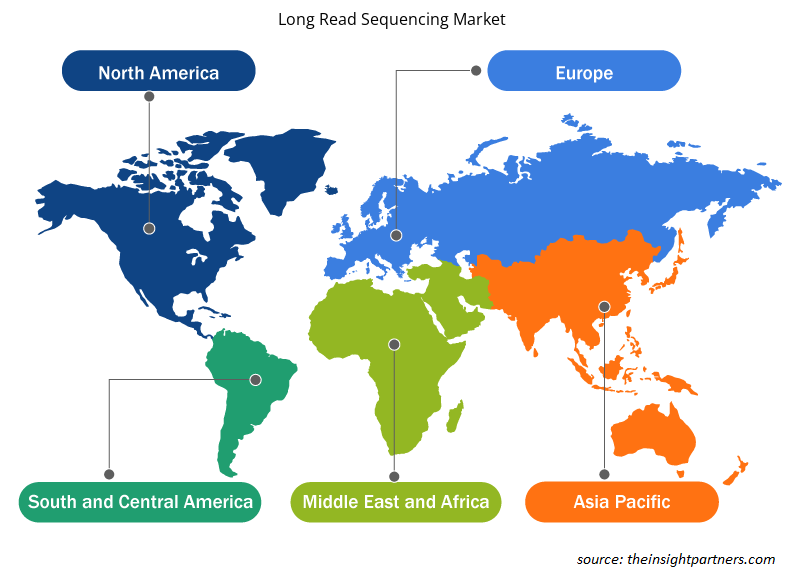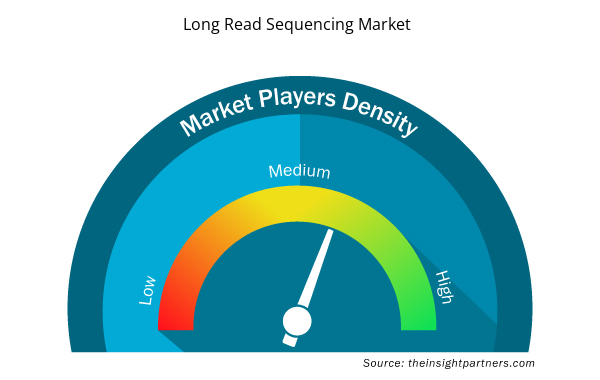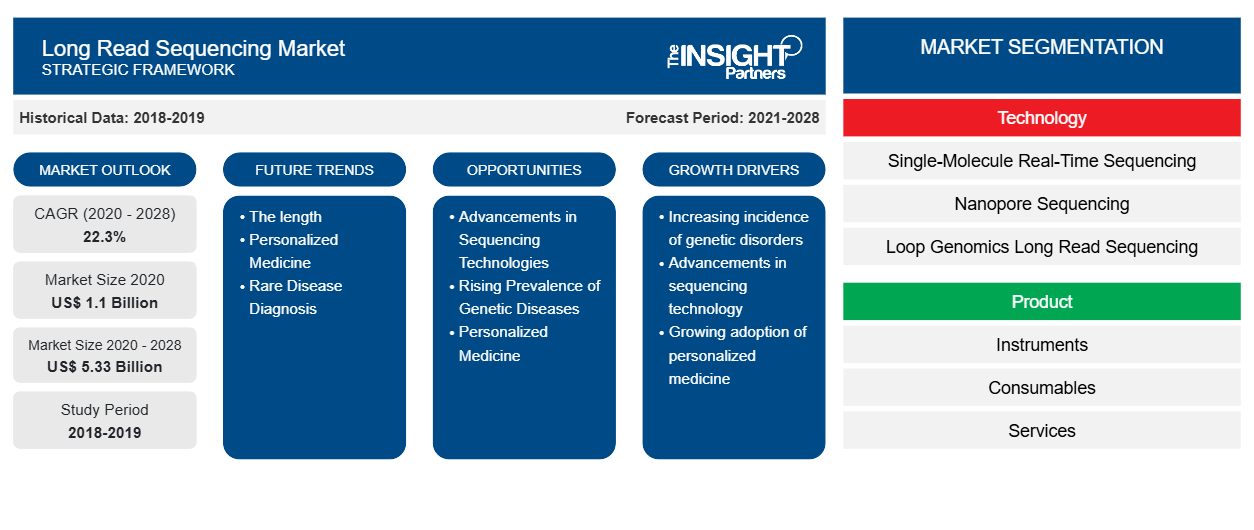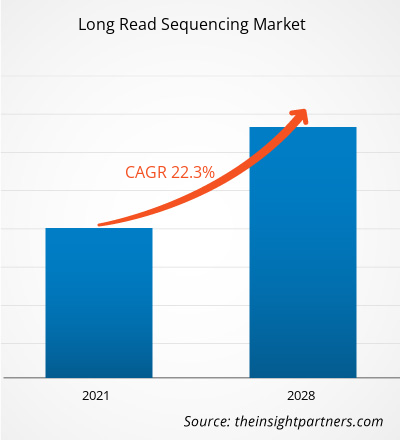Il mercato del sequenziamento a lettura lunga è stato valutato a 1.101,15 milioni di dollari nel 2020 e si prevede che raggiungerà i 5.334,68 milioni di dollari entro il 2028; si prevede una crescita a un CAGR del 22,3% nel periodo 2021-2028.
Il sequenziamento a lettura lunga è una tecnica di sequenziamento del DNA. Offre numerosi vantaggi distinti rispetto alle tecnologie di sequenziamento di nuova generazione, come la sequenza più precisa del DNA contenente le stesse sezioni di DNA ripetute all'interno del genoma. Molti adulti di età pari o superiore a 60 anni soffrono di due o più malattie croniche. I geni svolgono un ruolo nelle malattie croniche come malattie cardiovascolari, diabete, obesità, AR, morbo di Alzheimer (AD) e depressione, secondo la ricerca sui gemelli. Secondo i Centers for Disease Control and Prevention (CDC), circa 6 individui su 10 negli Stati Uniti sono affetti da almeno una malattia cronica, così come 4 su 10 soffrono di due o più malattie croniche. Inoltre, il cancro è causato principalmente da errori genomici. I ricercatori hanno analizzato i genomi del cancro utilizzando una varietà di tecnologie di sequenziamento in rapida evoluzione per comprendere meglio lo stato molecolare delle cellule tumorali ed esporre le loro vulnerabilità come mutazioni driver o espressione genica. I ricercatori sono stati in grado di riconoscere e classificare nuove forme di mutazioni cancerose utilizzando tecnologie long-read, tra cui varianti strutturali complesse nella risoluzione degli aplotipi. Negli ultimi anni, sono state sviluppate e utilizzate diverse tecnologie di sequenziamento long-read. Ad esempio, Pacific Biosciences ha sviluppato il sequenziamento SMRT, che è uno dei metodi long-read (PacBio). Il sequenziamento long-read sta diventando più comune e gli studi sul cancro basati su dati long-read stanno crescendo e avanzando per decodificare genomi cancerosi complessi.
Personalizza questo report in base alle tue esigenze
Riceverai la personalizzazione gratuita di qualsiasi report, comprese parti di questo report, o analisi a livello nazionale, pacchetto dati Excel, oltre a usufruire di grandi offerte e sconti per start-up e università
- Scopri le principali tendenze di mercato in questo rapporto.Questo campione GRATUITO includerà analisi di dati che spaziano dalle tendenze di mercato alle stime e alle previsioni.
Approfondimenti di mercato: i vantaggi del sequenziamento di lettura lunga guidano il mercato del sequenziamento di lettura lunga
Le tecnologie long-read stanno superando le limitazioni iniziali di accuratezza e produttività e stanno montando la loro applicazione nei campi della genomica. Il sequenziamento long-read o sequenziamento di terza generazione offre diversi vantaggi rispetto al sequenziamento short-read. Mentre i sequenziatori short-read come gli strumenti HiSeq, NovaSeq, NextSeq e MiSeq di Illumina, i modelli MGISEQ e BGISEQ di BGI; o i sequenziatori Ion Torrent di Thermo Fisher producono letture fino a 600 basi, le tecnologie di sequenziamento long-read generano regolarmente letture superiori a 10 kb. Inoltre, le long-read possono migliorare l'assemblaggio de novo, la certezza della mappatura, l'identificazione delle isoforme di trascrizione e il rilevamento delle varianti strutturali. Inoltre, il sequenziamento long-read di molecole native, ovvero DNA e RNA, elimina il bias di amplificazione preservando le modifiche delle basi. Grazie ai continui progressi in termini di accuratezza, produttività e riduzione dei costi, queste capacità hanno iniziato a rendere il sequenziamento di letture lunghe un'opzione per un'ampia gamma di applicazioni in genomica per organismi modello e non modello.
Tecnologia:Approfondimenti
Il mercato globale del sequenziamento a lettura lunga , basato sulla tecnologia, è segmentato in sequenziamento in tempo reale a singola molecola (SMRT), sequenziamento nanopore e sequenziamento a lettura lunga con genomica a loop. Il segmento del sequenziamento in tempo reale a singola molecola (SMRT) ha detenuto la quota maggiore del mercato nel 2020. Tuttavia, si prevede che il segmento del sequenziamento a lettura lunga con genomica a loop registrerà il CAGR più elevato nel mercato durante il periodo di previsione.
Prodotto: in base al prodotto, il mercato globale del sequenziamento a lettura lunga è segmentato in strumenti, materiali di consumo e servizi. Il segmento degli strumenti ha detenuto la quota maggiore del mercato nel 2020 e si prevede che il segmento dei servizi registrerà il CAGR più elevato nel periodo 2021-2028.
Applicazione: in base all'applicazione, il mercato globale del sequenziamento a lettura lunga è segmentato in identificazione e mappatura fine della variazione strutturale, sequenziamento tandem repeat, discriminazione pseudogenica, risoluzione della fase allelica, genomica riproduttiva, cancro, sequenziamento virale e microbico e altri. Il segmento dell'identificazione e della mappatura fine della variazione strutturale ha detenuto la quota maggiore del mercato nel 2020 e si prevede che il segmento del cancro registrerà il CAGR più elevato dal 2021 al 2028.
Flusso di lavoro: in base al flusso di lavoro, il mercato globale del sequenziamento a lettura lunga è segmentato in pre-sequenziamento, sequenziamento e analisi dei dati. Il segmento del sequenziamento ha detenuto la quota maggiore del mercato nel 2020 e si prevede che lo stesso segmento registrerà il CAGR più elevato nel periodo 2021-2028.
Utente finale: in base all'utente finale, il mercato globale del sequenziamento a lettura lunga è segmentato in istituti di ricerca accademica, ospedali e cliniche e aziende farmaceutiche e biotecnologiche. Il segmento degli istituti di ricerca accademica ha detenuto la quota maggiore del mercato nel 2020 e si prevede che lo stesso segmento registrerà il CAGR più elevato nel periodo 2021-2028.
Approfondimenti regionali sul mercato del sequenziamento di letture lunghe
Le tendenze regionali e i fattori che influenzano il mercato del sequenziamento di lunghe letture durante il periodo di previsione sono stati ampiamente spiegati dagli analisti di Insight Partners. Questa sezione discute anche i segmenti e la geografia del mercato del sequenziamento di lunghe letture in Nord America, Europa, Asia Pacifico, Medio Oriente e Africa e America meridionale e centrale.

- Ottieni i dati specifici regionali per il mercato del sequenziamento di lettura lunga
Ambito del rapporto di mercato sul sequenziamento di lettura lunga
| Attributo del report | Dettagli |
|---|---|
| Dimensioni del mercato nel 2020 | 1,1 miliardi di dollari USA |
| Dimensioni del mercato entro il 2028 | 5,33 miliardi di dollari USA |
| CAGR globale (2020 - 2028) | 22,3% |
| Dati storici | 2018-2019 |
| Periodo di previsione | 2021-2028 |
| Segmenti coperti | Per tecnologia
|
| Regioni e Paesi coperti | America del Nord
|
| Leader di mercato e profili aziendali chiave |
|
Densità degli attori del mercato: comprendere il suo impatto sulle dinamiche aziendali
Il mercato del Long Read Sequencing Market sta crescendo rapidamente, spinto dalla crescente domanda degli utenti finali dovuta a fattori quali l'evoluzione delle preferenze dei consumatori, i progressi tecnologici e una maggiore consapevolezza dei vantaggi del prodotto. Con l'aumento della domanda, le aziende stanno ampliando le loro offerte, innovando per soddisfare le esigenze dei consumatori e capitalizzando sulle tendenze emergenti, il che alimenta ulteriormente la crescita del mercato.
La densità degli operatori di mercato si riferisce alla distribuzione di aziende o società che operano in un particolare mercato o settore. Indica quanti concorrenti (operatori di mercato) sono presenti in un dato spazio di mercato in relazione alle sue dimensioni o al valore di mercato totale.
Le principali aziende che operano nel mercato del sequenziamento di letture lunghe sono:
- Illumina, Inc.
- Tecnologie Oxford Nanopore
- Biocentro TATAA
- PerkinElmer, Inc.
- F. HOFFMANN-LA ROCHE LTD.
Disclaimer : le aziende elencate sopra non sono classificate secondo un ordine particolare.

- Ottieni la panoramica dei principali attori del mercato del sequenziamento di lettura lunga
Gli operatori che operano nel mercato del sequenziamento di letture lunghe adottano strategie di collaborazione e partnership per soddisfare le esigenze degli utenti finali attraverso l'introduzione di offerte tecnologicamente avanzate; queste strategie supportano in modo significativo la crescita del mercato.
Per tecnologia
- Sequenziamento in tempo reale di singole molecole (SMRT)
- Sequenziamento dei nanopori
- Sequenziamento di lettura lunga di Loop Genomics
Per Prodotto
- Strumenti
- Materiali di consumo
- Servizi
Per applicazione
- Identificazione e mappatura fine della variazione strutturale
- Sequenziamento in Tandem Repeat
- Discriminazione pseudogena
- Risoluzione della fase allelica
- Genomica riproduttiva
- Cancro
- Sequenziamento virale e microbico
- Altri
Per flusso di lavoro
- Pre-sequenziamento
- Sequenziamento
- Analisi dei dati
Per utente finale
- Istituti di ricerca accademica
- Ospedali e Cliniche
- Aziende farmaceutiche e biotecnologiche
Per Geografia
America del Nord
- NOI
- Canada
- Messico
Europa
- Francia
- Germania
- Italia
- Regno Unito
- Spagna
Asia Pacifico
- Cina
- India
- Corea del Sud
- Giappone
- Australia
Medio Oriente e Africa
- Sudafrica
- Arabia Saudita
- Emirati Arabi Uniti
America del Sud e Centro
- Brasile
- Argentina
Profili aziendali
- Tecnologie Oxford Nanopore
- Biocentro Tataa
- Illumina, Inc
- Perkinelmer Inc.
- Società anonima F. Hoffmann-La Roche Ltd.
- Baseclear BV
- Genomica Bionano
- Tecnologie Longas
- Pacific Biosciences della California, Inc.
- Quantapore, Inc.
- Analisi storica (2 anni), anno base, previsione (7 anni) con CAGR
- Analisi PEST e SWOT
- Valore/volume delle dimensioni del mercato - Globale, regionale, nazionale
- Industria e panorama competitivo
- Set di dati Excel



Report Coverage
Revenue forecast, Company Analysis, Industry landscape, Growth factors, and Trends

Segment Covered
This text is related
to segments covered.

Regional Scope
North America, Europe, Asia Pacific, Middle East & Africa, South & Central America

Country Scope
This text is related
to country scope.
Domande frequenti
The dearth of skilled professionals is the significant factor that will hinder the long read sequencing market growth.
The global long read sequencing market is being driven by factors such as advantages of long read sequencing and increasing prevalence of chronic diseases are likely to offer significant opportunities for the growth of the global long read sequencing market.
Oxford Nanopore Technologies; Tataa Biocenter; Illumina, Inc; Perkinelmer Inc.; F. Hoffmann-La Roche Ltd.; and among others are major companies operating in this market.
Trends and growth analysis reports related to Life Sciences : READ MORE..
The List of Companies - Long Read Sequencing Market
- Illumina, Inc.
- Oxford Nanopore Technologies
- TATAA Biocenter
- PerkinElmer, Inc.
- F. HOFFMANN-LA ROCHE LTD.
- BaseClear B.V.
- Bionano Genomics
- Longas Technologies
- Pacific Biosciences of California, Inc.
- Quantapore, Inc.
The Insight Partners performs research in 4 major stages: Data Collection & Secondary Research, Primary Research, Data Analysis and Data Triangulation & Final Review.
- Data Collection and Secondary Research:
As a market research and consulting firm operating from a decade, we have published and advised several client across the globe. First step for any study will start with an assessment of currently available data and insights from existing reports. Further, historical and current market information is collected from Investor Presentations, Annual Reports, SEC Filings, etc., and other information related to company’s performance and market positioning are gathered from Paid Databases (Factiva, Hoovers, and Reuters) and various other publications available in public domain.
Several associations trade associates, technical forums, institutes, societies and organization are accessed to gain technical as well as market related insights through their publications such as research papers, blogs and press releases related to the studies are referred to get cues about the market. Further, white papers, journals, magazines, and other news articles published in last 3 years are scrutinized and analyzed to understand the current market trends.
- Primary Research:
The primarily interview analysis comprise of data obtained from industry participants interview and answers to survey questions gathered by in-house primary team.
For primary research, interviews are conducted with industry experts/CEOs/Marketing Managers/VPs/Subject Matter Experts from both demand and supply side to get a 360-degree view of the market. The primary team conducts several interviews based on the complexity of the markets to understand the various market trends and dynamics which makes research more credible and precise.
A typical research interview fulfils the following functions:
- Provides first-hand information on the market size, market trends, growth trends, competitive landscape, and outlook
- Validates and strengthens in-house secondary research findings
- Develops the analysis team’s expertise and market understanding
Primary research involves email interactions and telephone interviews for each market, category, segment, and sub-segment across geographies. The participants who typically take part in such a process include, but are not limited to:
- Industry participants: VPs, business development managers, market intelligence managers and national sales managers
- Outside experts: Valuation experts, research analysts and key opinion leaders specializing in the electronics and semiconductor industry.
Below is the breakup of our primary respondents by company, designation, and region:

Once we receive the confirmation from primary research sources or primary respondents, we finalize the base year market estimation and forecast the data as per the macroeconomic and microeconomic factors assessed during data collection.
- Data Analysis:
Once data is validated through both secondary as well as primary respondents, we finalize the market estimations by hypothesis formulation and factor analysis at regional and country level.
- Macro-Economic Factor Analysis:
We analyse macroeconomic indicators such the gross domestic product (GDP), increase in the demand for goods and services across industries, technological advancement, regional economic growth, governmental policies, the influence of COVID-19, PEST analysis, and other aspects. This analysis aids in setting benchmarks for various nations/regions and approximating market splits. Additionally, the general trend of the aforementioned components aid in determining the market's development possibilities.
- Country Level Data:
Various factors that are especially aligned to the country are taken into account to determine the market size for a certain area and country, including the presence of vendors, such as headquarters and offices, the country's GDP, demand patterns, and industry growth. To comprehend the market dynamics for the nation, a number of growth variables, inhibitors, application areas, and current market trends are researched. The aforementioned elements aid in determining the country's overall market's growth potential.
- Company Profile:
The “Table of Contents” is formulated by listing and analyzing more than 25 - 30 companies operating in the market ecosystem across geographies. However, we profile only 10 companies as a standard practice in our syndicate reports. These 10 companies comprise leading, emerging, and regional players. Nonetheless, our analysis is not restricted to the 10 listed companies, we also analyze other companies present in the market to develop a holistic view and understand the prevailing trends. The “Company Profiles” section in the report covers key facts, business description, products & services, financial information, SWOT analysis, and key developments. The financial information presented is extracted from the annual reports and official documents of the publicly listed companies. Upon collecting the information for the sections of respective companies, we verify them via various primary sources and then compile the data in respective company profiles. The company level information helps us in deriving the base number as well as in forecasting the market size.
- Developing Base Number:
Aggregation of sales statistics (2020-2022) and macro-economic factor, and other secondary and primary research insights are utilized to arrive at base number and related market shares for 2022. The data gaps are identified in this step and relevant market data is analyzed, collected from paid primary interviews or databases. On finalizing the base year market size, forecasts are developed on the basis of macro-economic, industry and market growth factors and company level analysis.
- Data Triangulation and Final Review:
The market findings and base year market size calculations are validated from supply as well as demand side. Demand side validations are based on macro-economic factor analysis and benchmarks for respective regions and countries. In case of supply side validations, revenues of major companies are estimated (in case not available) based on industry benchmark, approximate number of employees, product portfolio, and primary interviews revenues are gathered. Further revenue from target product/service segment is assessed to avoid overshooting of market statistics. In case of heavy deviations between supply and demand side values, all thes steps are repeated to achieve synchronization.
We follow an iterative model, wherein we share our research findings with Subject Matter Experts (SME’s) and Key Opinion Leaders (KOLs) until consensus view of the market is not formulated – this model negates any drastic deviation in the opinions of experts. Only validated and universally acceptable research findings are quoted in our reports.
We have important check points that we use to validate our research findings – which we call – data triangulation, where we validate the information, we generate from secondary sources with primary interviews and then we re-validate with our internal data bases and Subject matter experts. This comprehensive model enables us to deliver high quality, reliable data in shortest possible time.


 Ottieni un campione gratuito per questo repot
Ottieni un campione gratuito per questo repot